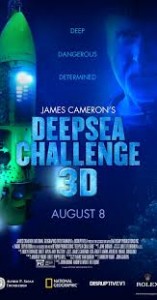Everyone who heard James Cameron proclaim “I’m the king of the world” after winning the Oscar for “Titanic” knows he has a huge pair.
But what many don’t realize is that prepping the 1997 blockbuster, which brought in more than $2 billion worldwide, was also a touchstone in his lifelong wanderlust to explore the deepest, darkest recesses of the ocean.
The audacious director’s quest to make a solo voyage to the bottom of the Mariana Trench is chronicled in the new “Deepsea Challenge 3D,” a dramatic 90-minute documentary of his odyssey in theaters nationwide August 8. It was a journey of historic proportions and risk, with the thrill of its many discoveries captured on camera. Tragedy also struck. Along the way, two of his crew members were killed in a helicopter accident.
The forbidding and mysterious trench is located in the Western Pacific east of the Philippines and is nearly 7 miles deep, deeper than Mount Everest is high – 36,000 feet. Think of the altitude a jetliner flies and that’s how far under the ocean we’re talking about.
For Cameron, it was a very personal journey to go to a place where only one expedition had been before, and that was 50 years ago.
U.S. Navy Lieut. Don Walsh and Swiss oceanographer Jacques Piccard had explored the trench in 1960, and Walsh was part of the Cameron team whose goal was to make the director’s journey the deepest solo dive in history.
He and his team of engineers and scientists built a submersible called the Deepsea Challenger, outfitting it with cameras inside and out that allow viewers to ride along on the exploration and experience the thrill of true discovery under the sea.
The film was produced by National Geographic and directed by John Bruno, Ray Quint and Andrew Wight, one of the two men who died in the helicopter crash while shooting aerials of the sub. The other fatality was Mike deGruy, an underwater cinematographer.
After much soul-searching, the rest of the crew and the families of the two men decided that the expedition should move forward.
“Things get real real quick,” Cameron said in an interview about the documentary. “The answer that came back from the group was to honor what Andrew and Mike stood for as explorers and complete the task.”
“Working with Jim, it’s always an adventure,” Bruno said in an interview. He’s a visual effects supervisor who has been with Cameron since the 1989 underwater adventure film “The Abyss.”
It was after “Titanic” that Cameron began devoting himself to the project and in 2005, with assistance from Australian cave diver Ron Allum, began designing the sub – paying for most of the costs himself with support from National Geographic and Rolex.
He won’t say how much the tab was but noted that the cost of similar government expeditions in today’s dollars would be $100-$150 million.
The submarine is 24 feet tall and weighs 11.5 tons. It was worked on by two teams of engineers, one in Silicon Valley and another in Sydney, Australia.
When Cameron took his solo dive in it on March 26, 2012, the thrusters failed and he was able to stay down just three hours – two hours less than he planned – before returning to the surface, which took about 70 minutes. From samples he collected from the ocean floor and analysis of HD images from the journey, at least 100 new species have been identified.
Just a day after accomplishing the historic dive, Cameron headed to London for the premiere of “Titanic 3D.” Now, he’s working on three sequels to “Avatar.” It helps him pay the bills, he says.
–Hillary Atkin



